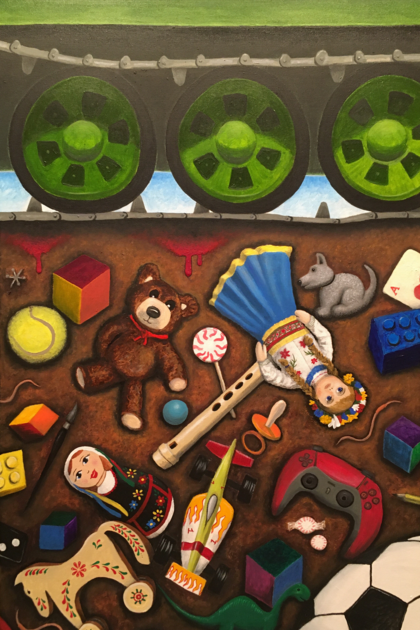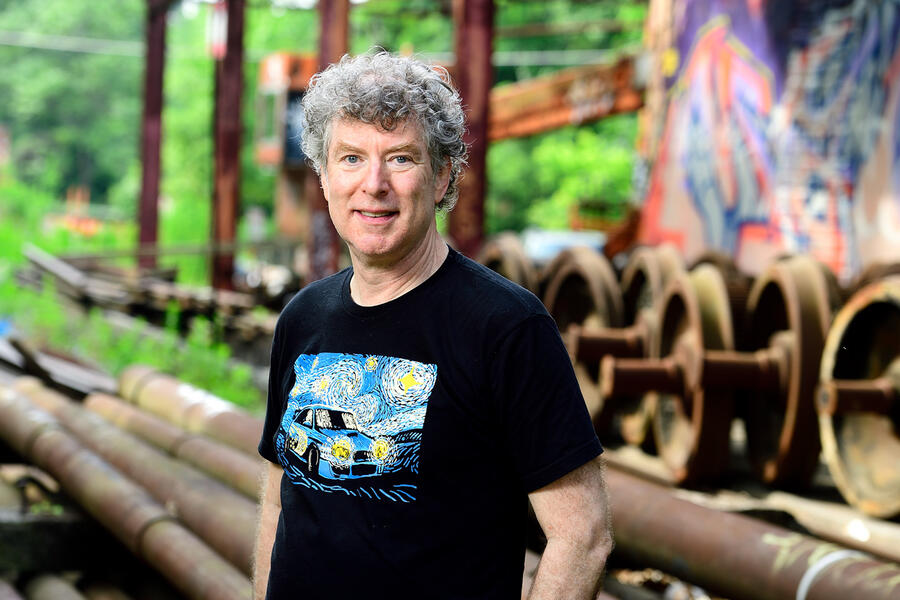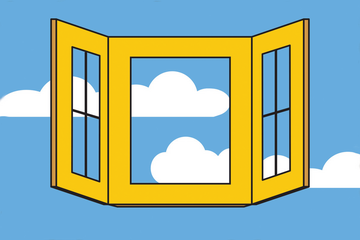My Other Life is an At Work series that lets us get to know our Johns Hopkins colleagues better. Do you, or does one of your co-workers, have a personal passion that would make a good story? Let us know at hubatwork@jhu.edu. Want to read more of the series? Go here.
Michael Stevens Wiggs traces the origins of his art to his childhood days at Great Plains Elementary School in Danbury, Connecticut, and to Gary, his grade school classmate and friend. The two spent many hours together drawing caricatures—they called them called "kooky pictures"—in their respective notebooks, sketches since lost to time but at least never confiscated by their teachers.
"They were drawings of fun, nonserious things, and nothing was off-limits—kids, teachers, everybody," he recalls. "We expressed our sense of humor with drawings.
"We did all kinds of things—weird flying machines, medieval battles, cars, but mostly distorted and funny-looking people. We were definitely influenced by the Wacky Packages stickers," he adds, referring to humor-filled trading cards first released in 1967 that depicted consumer products. "Most kids bought baseball cards; I got Wacky Packages. I had a huge collection, but, sadly, I have no idea what's happened to them."
Today his art—abstract and surrealistic in style—is worlds away from those not-so-serious drawings. His tone is often somber and discomforting, reflecting the intersection between humans and humanity, specifically the effects of people's behavior on the environment and on other humans.
He blends images of fantasy and science fiction that are seasoned with urgency, aimed in particular at the pressing social, environmental, and political challenges confronting our planet, asking viewers "to examine the consequences of their consumer choices and ponder the balance between wasteful materialism and ecological preservation," he says.
When he started painting in earnest, he says, "I began with stylized organic forms, mostly trees with the leaves rendered like a stained glass of sorts. I wanted to simplify the form, especially the multitudes of leaves, and also retain the beauty. I've always been aware of pollution and humanity's callous disregard for nature. Now I have to include that in the work. I just can't paint a tree anymore—I have to paint what's happening to the tree."
During the week, his focus takes a different turn.
Wiggs is a data specialist in Johns Hopkins University's Human Resources Benefits and Compliance Operations center who tracks and writes reports on how people use their workplace benefits, specifically Maryland Sick and Safe Leave.
This may at first seem incompatible with his artistic inclinations, but it's consistent with his training and background.
He holds a graduate degree in astronomy. His first job was as an analyst with the Space Telescope Science Institute, a NASA-funded contractor that runs the missions for the Hubble and James Webb telescopes and has offices on and near JHU's Homewood campus. One of his responsibilities was to monitor the calibration of the Wide Field Planetary Camera-2 instrument, known as WFPC2, onboard the Hubble.
He started at STScI in 1991, left in 2012 for a job in private industry "which I did not enjoy," and found an opportunity at JHU during the COVID pandemic to manage three testing sites for students, who were required to undergo periodic screening. When the data specialist job he now holds opened up in 2021, he applied.
"It suits me well," he says. "It's the right amount of problem solving and routine work. Being a space telescope analyst was good experience for this. Numbers are numbers."
Off campus, he speaks through his acrylics, sometimes mixed with colored pencil, ink, and found objects, depending on the desired effect. "It feels good to let these things out," he says. "I don't do as well with words. I can express myself through painting and feel good about it. That's why I do it. But I also want to keep perfecting it."

Image caption: Wiggs’ ‘Ukrainian Childhood,’ acrylic on canvas, 36” x 24”
As someone with an admittedly "restless mind" who "always enjoyed learning things, especially how nature worked," he went through high school "dabbling a bit" in art but equally interested in science.
But the experience of seeing Pablo Picasso's larger-than-life masterpiece Guernica at the Museum of Modern Art in New York City, where it was on loan for many years, intensified his feelings about pursuing art.
The epic oil painting depicts the brutality of war, specifically the April 26, 1937, bombing of Guernica, a town in the Basque country in northern Spain, by Nazi Germany and fascist Italy, with images of death and destruction not easily forgotten. He was gobsmacked by its power.
"When I saw Guernica up close—looking at [Picasso's] style—it's a huge piece and so profound. Oh, wow,'" he recalls. "What hit me the most, aside from the scale of the piece, was the brushwork, the expertise, the ability to depict such a scene with simple lines and forms. You don't get the full sense of these things from a picture in a book. I remember thinking It's OK to do art. I could do this.
He worked mostly pencil-on-paper drawings until he finished graduate school, when he began to paint. Although he took some art classes as an undergraduate, he did not major in art or consider it a future career. "I always saw it as mostly a hobby," he says.
After he moved to Baltimore in 1991, he began to take painting more seriously, showing his work at exhibits, in coffee shops, and elsewhere, and, as word got around, people started to buy it. He estimates that he's sold about 40 pieces over the years, "although definitely not enough to quit my day job," he says.
In the early '90s, when Netscape—one of the first web browsers—was released, officials at the Space Telescope Science Institute decided to build a website. Wiggs became webmaster for the WFPC2 instrument team, which sent him to nearby MICA for a semester of graphic design classes. "So you could say I have some formal training at an art institution," he says, adding that he has since taken additional classes at the college. "It's always good to keep learning, and to be around other creatives."
A friend persuaded him to show some of his work in 2003 at Shore Leave, "a fan convention for Star Trek and sci-fi that took place in Baltimore," he says. "Part of the event was an exhibit for fan art, though not specifically on Star Trek. I brought down some pieces, but I couldn't stay." When he returned later that weekend to pick up his paintings, he found a red-and-blue ribbon attached to them. He'd won second place. "That was pretty cool and gave me some encouragement to keep going," he says, "so I kept working at it."
Today he shows in artist-run galleries and recently joined the Towson Arts Collective, a co-op of artists, and has been a member of the Creative Alliance in Highlandtown for years. "These groups provide opportunities to show work, gain exposure, participate in art education programs, and to interact with other artists," he says, adding that he is showing a piece this summer at The Big Show, a major Creative Alliance exhibit that runs through Aug. 11. His portfolio also can be found on the Baker Artist Portfolios site run by the Greater Baltimore Cultural Alliance.
"I wanted to increase my visibility, and the Baker Portfolios was a good fit. It's free, it's local, and it provides a one-stop site to see work by artists from the Baltimore area," he says.
He describes his current work as "surrealistic, or maybe abstracted realism," portraying the intersection between humans' use of technology and its destructive effects on the environment. He is especially interested, he says, in the concept of incorporating technology, such as computer bits, into the human body. "I don't see any good coming out of that."
He also recently painted a three-piece series expressing his horror at Russia's invasion of Ukraine. "I had to vent," he says. One piece shows the ruin of a city—its destruction—with Russian tanks and, in the background, a hand holding a Molotov cocktail. "I was impressed with how the Ukrainian government put up billboards explaining how to make Molotov cocktails," he says. Another depicts children's toys being crushed into the mud by Russian tanks. The third is of Putin standing in front of a river of blood with many graves on either side of the river.
He long ago lost touch with his friend Gary but remains grateful for his early influence, as well as for the support of his teachers who understood and encouraged his artistic impulses.
"I remember one of my art teachers in high school at a parent-teacher conference, in response to a question from my parents about why my art looked so different from that of other kids—all the surrealist flourishes and random things that made no sense to anyone but me—she said, 'We just let Mike do whatever he wants to do.'"
Posted in News+Info
Tagged my other life









